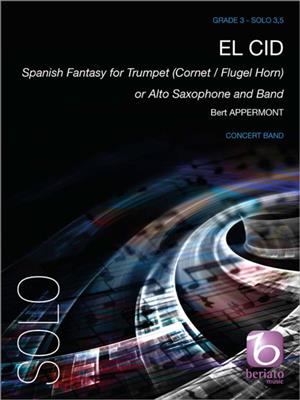Results
-
 £102.99
£102.99The Round Table - Bert Appermont
The Round Table, a project of the concert band "Odyssey" in Belgium, was specially composed to present the various instrumental groups and separate instruments of the orchestra. With this sparkling composition you can familiarise the audience with the wealth of sounds and the strength of your ensemble. As an opening or concert piece.
Estimated dispatch 7-14 working days
-
 £109.99
£109.99The Cross & The Crown - Bert Appermont
This brilliant concert march was written to celebrate the 150th anniversary of the founding of "Les Voltigeurs de Qubec". The title of the work refers to the emblem of this Canadian regiment, in which both the cross and the crown aredepicted. This piece aims above all to express the joy of this special anniversary. The melancholy trio section brings to mind more turbulent times and the trials and tribulations that the regiment has experienced at various points of its history.
Estimated dispatch 7-14 working days
-
 £169.99
£169.99The Adventures of Baron Munchausen - Bert Appermont
This work is based on the famous stories of Baron Mnchhausen. In these tall tales, the baron undertook all sorts of fabulous adventures. He flew, for example, on a cannonball, or rode on a horse torn in two, he turned a hungry wolf inside out, andpulled himself out of a swamp by his own hair.Four of the tales served as the inspiration for this composition. The music isn't simply a word-for-word transcription of the stories, however, but rather conveys a particular mood or specific scene, often with a humorous twist.
Estimated dispatch 7-14 working days
-
 £294.99
£294.99Concerto for Horn and Band - Bert Appermont
Concerto for Horn and Band was written on commission from the horn player Miguel Martinez Megias and the symphonic concert band La Armnica from Buol, Spain. This four-movement work, written to fully explore the capabilities of the hornas a solo voice, is comprised of a dramatic Sarabande, a highly virtuoso Toccata, a wonderful Romance and a Finale that reworks the second movement in a kind of fugue and brings the work to a spectacular close. The basicbuilding block of this concerto, quite fittingly, is the fifth: you only have to think of the post horn or a hunting theme, which conjures up the sound of the perfect fifth. Wonderful new repertoire for a wonderful instrument.
Estimated dispatch 7-14 working days
-
 £104.99
£104.99Aurum - Bert Appermont
The magnificent concert march Aurum (lat. gold) was written on the occasion of the 50th anniversary of the cunductor of the municipal band of Wolfach, in Baden-Wrttemberg, Germany. The march begins with a light and playful theme. The following lyrical trio provides a contrast, with its nod to Edward Elgar. After a number of key changes the introductory theme returns in canon. Finally, the music heads to a majestic finale, inwhich the trio theme is played as a splendid baroque chorale.
Estimated dispatch 7-14 working days
-
 £84.99
£84.99Return of the Vikings - Bert Appermont
This composition paints a picture of belligerent and brave Vikings. After a short introduction the lofty main theme is heard, accompanied by sombre drum sounds. A brief idyllic passage follows that evokes a beautiful landscape. Gradually, a heroicmelody is revealed, leading to a great tutti, in which the rousing main theme is heard once more. Return of the Vikings closes with the sound of heroic brass and festive chords.
Estimated dispatch 7-14 working days
-
 £137.99
£137.99El Cid - Bert Appermont
El Cid was the name of the legendary knight and folk hero Rodrigo D az de Vivar Cameador, the man who never lost a duel. After a typically Spanish opening, a slower section follows in which the composer makes reference to Albinoni'sAdagio and to the slow movement from Joaqu n Rodrigo's Concierto d'Aranjuez. The music is whipped up with Spanish passion at the close, and castanets are a must! The solo part can be played by trumpet, flugelhorn, cornet oralto saxophone and is also available in a simplified version.
Estimated dispatch 7-14 working days
-
 £137.99
£137.99Treasure Island - Bert Appermont
This composition was inspired by the adventure novel Treasure Island by the Scottish author Robert Louis Stevenson. The music does not recount the tale verbatim, but rather sketches particular events and moods in scenes.
Estimated dispatch 7-14 working days
-
 £76.99
£76.99Hymn of Glory - Bert Appermont
This melodic hymn begins with a lyrical melody, handled by various instrument groups. After a gradual build, a first climax is reached, in which the brass instruments give full vent to their glorious sound in jubilation. Now we hear a second theme,resounding in the euphoniums, which ushers in a moment of rest. Then the excitement gathers again, building to a great tutti. The main theme is taken up once more, sounding now as a kind of universal gratitude.
Estimated dispatch 7-14 working days
-
 £84.99
£84.99The Soldier & The Princess - Bert Appermont
This work is based on the story of the soldier and the princess from the film Cinema Paradiso. The story is about a poor soldier who fell in love with a beautiful princess. He had nothing to offer her, but he managed to meet her and declared his love for her. Do you want to know what happens next...?
Estimated dispatch 7-14 working days
